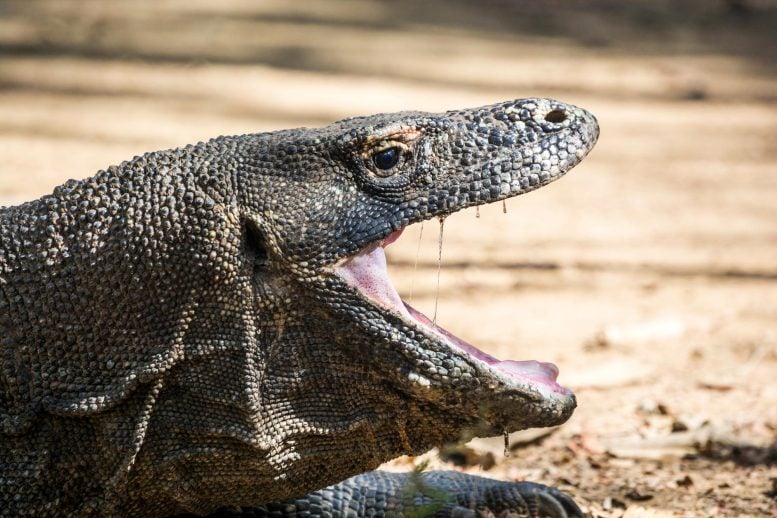
Komodo dragons’ teeth contain concentrated iron at their tips, keeping them razor-sharp, akin to the teeth of meat-eating dinosaurs, providing clues to dinosaur dietary habits.
Scientists from King’s College London discovered that Komodo dragons’ serrated teeth are enhanced with iron, particularly concentrated along the cutting edges.
This feature, staining the teeth orange, helps keep them exceptionally sharp. The study analyzed teeth from Komodo dragons and explored potential similarities with dinosaur feeding behaviors, suggesting that this characteristic may provide insights into how dinosaurs like Tyrannosaurus rex might have used their teeth.
Komodo Dragons and Their Iron-Infused Teeth
Scientists have discovered that the serrated edges of Komodo dragons’ teeth are tipped with iron.
Led by researchers from King’s College London, the study gives new insight into how Komodo dragons keep their teeth razor-sharp and may provide clues to how dinosaurs like Tyrannosaurus rex killed and ate their prey.
Native to Indonesia, Komodo dragons are the largest living species of monitor lizard, averaging around 80kg. Deadly predators, Komodos have sharp, curved teeth similar to many carnivorous dinosaurs. They eat almost any kind of meat, from smaller reptiles and birds to deer, horses, or water buffalo, pulling and tearing at their prey to rip flesh apart.
Komodo dragons, native to a few Indonesian islands, are the largest living lizards in the world, reaching lengths of up to 10 feet and weighing over 300 pounds.
The Role of Iron in Komodo Dragon Tooth Durability
The researchers discovered that many reptiles have some iron in their teeth, but Komodo dragons have concentrated the iron along the cutting edges and tips of their teeth, staining them orange. Crocodiles and other monitor lizards, by comparison, have so little that the iron is often invisible.
To understand the chemical and structural make-up of Komodo dragon’s teeth, scientists scoured museums for skulls and teeth of Komodo dragons and studied the teeth of Ganas, the 15-year-old Komodo dragon who had lived at ZSL conservation zoo, London Zoo.
Through advanced imaging and chemical analysis, the team was able to observe that the iron in Komodo dragons’ enamel is concentrated into a thin coating on top of their tooth serrations and tips. This protective layer keeps the serrated edges of their teeth sharp and ready to be used at a moment’s notice.
The research, published on July 24 in Nature Ecology & Evolution, leads to new questions and avenues for research into how extinct species such as dinosaurs lived and ate.
Komodo dragons are formidable predators that possess sharp, curved teeth and a powerful tail. They are known for their exceptional hunting ability, which includes a venomous bite that helps them take down prey ranging from birds to large mammals.
Comparing Komodo Dragon and Dinosaur Teeth
Dr. Aaron LeBlanc, lecturer in Dental Biosciences at King’s College London and the study’s lead author said: “Komodo dragons have curved, serrated teeth to rip and tear their prey just like those of meat-eating dinosaurs. We want to use this similarity to learn more about how carnivorous dinosaurs might have eaten and if they used iron in their teeth the same way as the Komodo dragon.
“Unfortunately, using the technology we have at the moment, we can’t see whether fossilized dinosaur teeth had high levels of iron or not. We think that the chemical changes that take place during the fossilization process obscure how much iron was present to start with.
“What we did find, though, was that larger meat-eating dinosaurs, like tyrannosaurs, did change the structure of the enamel itself on the cutting edges of their teeth. So, while Komodo dragons have altered the chemistry of their teeth, some dinosaurs altered the structure of their dental enamel to maintain a sharp cutting edge.
“With further analysis of the Komodo teeth, we may be able to find other markers in the iron coating that aren’t changed during fossilization. With markers like that, we would know with certainty whether dinosaurs also had iron-coated teeth and have a greater understanding of these ferocious predators.”
Future Directions and Conservation Efforts
Dr. Benjamin Tapley, Curator of Reptiles and Amphibians at ZSL and co-author on the study said: “As the world’s largest lizards, Komodo dragons are inarguably impressive animals. Having worked with them for 12 years at London Zoo, I continue to be fascinated by them and these findings further emphasize just how incredible they are.
“Komodo dragons are sadly endangered, so in addition to strengthening our understanding of how iconic dinosaurs might have lived, this discovery also helps us build a deeper understanding of these amazing reptiles as we work to protect them.”
Reference: “Iron-coated Komodo dragon teeth and the complex dental enamel of carnivorous reptiles” by Aaron R. H. LeBlanc, Alexander P. Morrell, Slobodan Sirovica, Maisoon Al-Jawad, David Labonte, Domenic C. D’Amore, Christofer Clemente, Siyang Wang, Finn Giuliani, Catriona M. McGilvery, Michael Pittman, Thomas G. Kaye, Colin Stevenson, Joe Capon, Benjamin Tapley, Simon Spiro and Owen Addison, 24 July 2024, Nature Ecology & Evolution.
DOI: 10.1038/s41559-024-02477-7
>>> Read full article>>>
Copyright for syndicated content belongs to the linked Source : SciTechDaily – https://scitechdaily.com/komodo-dragons-flaunt-iron-tipped-nightmare-teeth-scientists-discover/